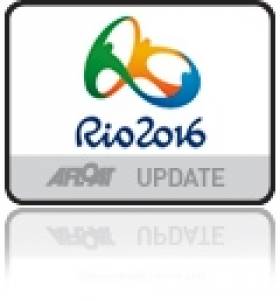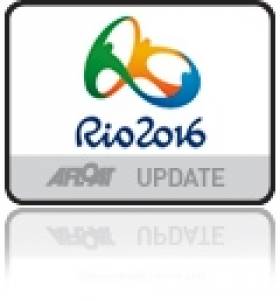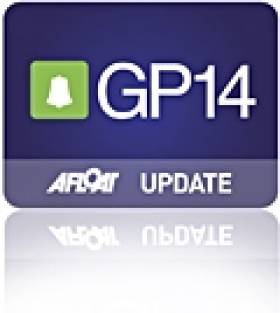Displaying items by tag: Olympic
Kiteboarding Makes its Debut at ISAF World Cup Event in Spain
#isafworldcup – The 44th edition of the Trofeo SAR Princesa Sofia Mapfre for Olympic classes, the first European ISAF Sailing World Cup stop, will include Kiteboarding as an invited class. The kites will sail for the very first time in the most international regatta held in Spain, sharing the racing area in the bay of Palma de Mallorca (Spain) with the Olympic classes from 30th March to 6th April.
The Trofeo SAR Princesa Sofia Mapfre to be held this year at the venues of Club Nàutic S'Arenal, Club Marítimo San Antonio de la Playa and Pabisa Beach Club, has invited the kiteboarding to the regatta in view of its possible future inclusion in the ISAF Sailing World Cup and the Olympic Games. Last year ISAF included this innovative class in the Rio 2016 Olympic programme replacing the windsurfing, a decision that was finally revoked in extremis at the November Annual meeting in Dun Laoghaire.
The Trofeo SAR Princesa Sofia will count for the IKA World ranking together with other international events. 4 racings days are scheduled from 2nd to 5th April followed by an exhibition day on 6th, the Medal Races day for Olympic classes.
"The International Kiteboarding Association is more than happy to secure the inclusion in this important event, as it brings another excellent opportunity to prove how kiteboarding can be included in the major ISAF sailing events", declared Markus Schwendtner, the class Executive Secretary.
"The organisers of the Sofia Mapfre are working to innovate and contribute to make sailing a more spectacular sport. The initiative of including kiteboarding, supported by the Spanish Sailing Federation as well as ISAF, is a step towards this goal", explained Ferran Muniesa, the event CEO.
The kites will be based on the beach opposite the Trofeo Princesa Sofia Mapfre village, located at the Pabisa Beach Club. Pabisa is a leisure centre located at Playa de Palma, between the two other venues of the 44 Sofia Mapfre, and like last year it will be the regatta village, an excellent meeting point to follow the racing and venue of social events.
Club Nàutic S'Arenal will be the venue of Paralympic classes 2.4mR, Skud 18 and Sonar and Olympic classes Finn, 470 men and women, 49er and 49er FX, the latter having its debut in Palma as the new Women's skiff.
The venue for classes Laser Standard and Radial, RS:X men and women and Nacra, the new mixed two person multihull will be Club Marítimo San Antonio de la Playa.
Annalise in Pole Position for Today's Medal Races
#roadtorio – Annalise Murphy stormed back to regain the overall lead at Miami Olympic Classes regatta yesterday and goes in to today's medal races as top sailor after a week long battle of 13 races in her 29-boat Laser Radial fleet.
Sparkling conditions on Biscayne Bay and 20-knot winds gave Ireland's 'Breeze Queen' the perfect opportunity to strike home her heavy air advantage.
In what has been descirbed as the stand out performance of all the 400 competing sailors yesterday Annalise won the final two races to take a four point lead over Paige Railey of the United States. Railey won race 13 today and is in second place so still poses a mjro risk in today's medal race.
Murphy is racing for Ireland's first ever World Cup win in the Laser Radial class, a feat that would be a terrific boost to on her first regatta on the road to Rio 2016.
The Lasers and Laser Radials are testing an experimental format this week in Miami. Sailors receive zero points for each race they win. Their first fleet series standings through six races translated into a single carryover race score applied to the new series which started Thursday. The new series included one discard which could be the carryover race. Following the next five races and six total scores, the top ten advance to the medal races on Saturday. The top ten will sail three medal races on Saturday. Each medal race is double points and non-discardable. Final score is the six race series which began yesterday plus the medal race scores.
The first ISAF Sailing World Cup Miami medalists of 2013 were determined on day five. Men’s and Women’s RS:X events conducted semifinal and final round races. The 2.4 mR and Sonar fleets of the Paralympic events took part in their final day of fleet racing.
Israel’s Maayan Davidovich and Spain’s Ivan Pastor saved their best for last in the Women’s and Men’s RS:X events. Davidovich had one win prior to the finals and Pastor had none. They each won their dramatic, winner take all final race to capture gold.
Pastor, a two-time Olympian in 2012 and 2008, was ecstatic about his first ISAF Sailing World Cup title. “It feels incredible to win one of these great World Cup events,” he said. “The conditions were ideal for me with the strong wind. It was more stable and I maneuvered well to get in position.”
The 2012 Olympic silver medalist and defending ISAF Sailing World Cup Miami Champion Nick Dempsey (GBR) finished second to gain silver medal honors. The 2012 Olympic gold medalist and three-time champion of this event finished with the bronze medal. He won five out of 10 races this week.
Davidovich was equally excited about her first World Cup gold medal. “I’m happy to share the podium with Tuuli (Petaja-Siren) and Blanca (Manchon),” said Maayan. “I wasn’t the fastest on the water, but I had a good regatta. This is my first important race for the Rio campaign, so it’s good to start off on the right foot. I love Miami and I’m looking forward to racing here again.”
Finland’s Tuuli Petaja-Siren, the 2012 Olympic silver medalist, won another silver medal with her second place finish. She won four of the 10 races this week. Blanca Manchon, a former World Champion, was third for the bronze medal.
After a recommendation from the Olympic Classes Sub-committee at the 2012 ISAF Annual Conference, Olympic classes have recommended formats to ISAF for testing. The RS:X Class Association’s proposed format has been trialed throughout the week in Miami. The RS:X World Championships take place February 28 to March 7 in Buzios, Brazil.
Great Britain’s Megan Pascoe won her first two races of the week today to seal the win in the 2.4 mR event. Pascoe did not post a finish worse than second following race four out of 10. She tallied six second place finishes. Pascoe won by three points over Canadian Allan Leibel, who was second in both races today. Leibel took the silver medal, while Bruce Millar (CAN) secured the bronze.
Pascoe was fourth last year in Miami and third in the 2.4 mR World Championships last September. The 2013 International 2.4 mR Open World Championship takes place take place September 6-14 in Britain.
Aleksander Wang-Hansen, Marie Solberg and Per Eugen Kristiansen of Norway won the gold medal in the Sonar event and finished strong today with a win in race 10. They were second in race nine. Wang-Hansen and his crew won by a nine point margin. The 2012 Olympic bronze medalists won four races this week. Two American teams secured silver and bronze medals. Andrew Fisher, Mike Hersey and Ryan Levinson took the silver, while Rick Doerr, Brad Kendell and Hugh Freund won bronze.
“We’ve been working hard together for years now and it’s paying off,” said Wang-Hansen. “We have a long way to go, but it’s full speed ahead for Rio.”
49ers Ryan Pesch and Trevor Burd (USA) gained ground on leaders Fred Strammer and Zach Brown (USA). Pesch and Burd tallied impressive scores today by finishing second, first and fourth to pull within two points of the leaders. Strammer and Brown were fourth, second and fifth.
Brazil’s Martine Grael and Kahena Kunze kept their five point lead today in the 49er FX. They were victorious in race 13 and second in race 14. American’s Anna Tunnicliffe and Molly Vandemoer are in second place.
The top six teams in the 49er and 49er FX events will advance to Saturday’s respective medal races. The medal races will be conducted using a unique format and challenging course. The theater style course includes two enclosed parallel lanes approximately 400 meters long and 220 meters wide. The target time for race duration is 10 minutes, with the goal of three laps. The first boat to win two races wins the regatta. Teams entering the medal races with the lead from the fleet series will begin this stage with a win.
Charlie Buckingham surged to the top of the Laser leaderboard this afternoon. He won race 13, which counts as zero points (bonus point for race wins), was second in race 14, and 17th (discard) in the final race of the day.
Perhaps no sailor had a stronger performance today than Ireland’s Annalise Murphy of the Laser Radial event. She won the final two races to take a four point lead over Paige Railey of the United States. Railey won race 13 today and is in second place.
The Lasers and Laser Radials will feature a creative medal round series on Saturday. The top ten will sail three medal races. Each medal race is double points and non-discardable. The final score is the six race series which began Thursday, plus the medal race scores. For more information on this format, read the explanation at the end of this recap.
Caleb Paine (USA) will have a 10 point lead going into Saturday’s medal race. The Finn U.S. National Champion was fourth and second today. Canadian Greg Douglas moved into second place by finishing third twice. The World #1 and ISAF Sailing World Cup Melbourne Champion Brendan Casey (AUS) won both races today, but a 29 (DNE – disqualification not excludable) on Thursday set him back going into today. He ended the day in sixth place.
Sarah Newberry and John Casey (USA) have a strong hold on the number one spot in the Nacra 17 event. Newberry and Casey finished first and second today and led by 11 points over Sarah Streater and Matthew Whitehead (USA). They were also first and second today.
In the Men’s 470, Matthias Schmid and Floran Reichstaedter (AUS) gained ground with a pair of wins, yet trail by seven points. Stuart McNay and David Hughes of the U.S. scored second and third place results and will be the top team heading into the medal race on Saturday. Xiaoli Wang and Xufeng Huang (CHN) won both Women’s 470 races to pull within nine points of leaders Fernanda Oliveira and Ana Luiza Barbachan (BRA). Both 470 fleets raced together on Friday.
The Schedule of Races for Saturday, February 2:
Course Alpha:
1000 – Nacra 17 Medal Race
1045 – Finn Medal Race
1145 – 49er Medal Stage (up to 6 races)
1245 – 49er FX Medal Stage (up to 6 races)
Course Bravo:
1000 – 470 Men's Medal Race
1045 – 470 Women's Medal Race
1130 – Laser Medal Stage (3 races)
1400 – Laser Radial Medal Stage (3 races)
Annalise Murphy Loses Overall Miami Lead But Stays in Contention
#road to rio – Annalise Murphy lost her overall lead at the Miami Olympic classes regatta in Florida this afternoon but the Irish solo sailor stays very much in contention as the competition enters its final stage.
American Olympian Paige Railey, sailing on home waters, now has an overall edge of two points going into Friday's final two races before Saturday's Laser Radial Medal Race on Biscayne Bay.
In the above video (from three minutes 28 seconds) there are some clips of Annalise leading, then hitting a weather mark in the final race yesterday afternoon.
Biscayne Bay was surrounded by overcast conditions on Thursday. Wind speed fluctuated throughout the day and ranged from as light as four knots to as high as 15
The Laser Radials started a new series on Thursday.
Paige Railey (USA) asserted herself by winning the two of three races. She has won three of the last four races to take a two point lead. Her discard is a six. Finishing second twice today was Murphy. She started the new series with a lead. The World #5 Tuula Tenkanen won race seven.
It was a critical day of racing for the ten Olympic and two Paralympic classes at the 2013 ISAF Sailing World Cup Miami. As the fleet series winds down for these events and in some cases new racing formats go into motion, the time is now for sailors to make a run at the leaderboard.
The regatta's largest event this year is the Laser, which features 70-boats in gold and silver fleets. Sweden's Jesper Stalheim finished the first series, which concluded yesterday, with the lead and he finished today on top of the leaderboard in the new series. He was third and second today, while Charlie Buckingham (USA) overtook second place after winning race nine in the new series. The World #3 Bruno Fontes is in third.
"With the new carryover system and the bonus points for wins they have here for scoring, I'm not sure what will happen. It should be interesting," said Stalheim. "Yesterday, everything fell into place. I'm here to work on my starts and I did well with that. It's a really good fleet this week, especially a year after the Olympics." Stalheim finished third at the Laser European Championship (France) in June and won the Laser Europa Cup (Denmark) in September.
Fontes finished #13th at the Olympics and second last year at World Cup Miami. "Keeping the clean starts with good speed has helped me a lot this week," said Fontes. "I'm a smaller guy so to be good in strong wind I need to work a lot in the gym. Now I need to improve a bit more in light wind because the main goal is Olympics, and Rio is light wind. For me, Rio is the highest goal in my life. With the Olympics in my home country, I am excited to work hard to be ready and do my best to get a medal."
The Finns wrapped up another competitive day of racing and Caleb Paine (USA) extended his lead to seven points. The Finn U.S. National Champion won race seven and was third in race eight. World #1 and ISAF Sailing World Cup Melbourne Champion Brendan Casey (AUS) is in second. He was third and second today. Casey is impressed with the new wave of talent in the Finn class.
"I've come to Miami to race against the world's best that are currently sailing to see where I stack up," said Casey. "I'm 35 years of age now, so I'm probably at the tail end of my sailing, but I'm still very competitive. The younger guys like Caleb Paine are at the start of their sailing journey and Greg Douglas too. Those are the two guys to watch out for in the future."
In the Men's 470, Matthias Schmid and Floran Reichstaedter (AUS) had a disappointing day on the water and American's Stuart McNay and David Hughes catapulted to an 11-point lead. McNay and Hughes were second and first in today's races, while Schmid and Reichstaedter were 10th and 11th. The 11 becomes their discard and the 10 applies to their score.
In the Women's 470, Brazil's Fernanda Oliveira and Ana Luiza Barbachan are pulling away. Their win in race seven and fifth in race eight put them in the lead by 12 points over China's Xiaomei Xu and Chunyan Yu.
Dorian Van Rijssbelberghe (NED) excelled in Thursday's quarterfinal series by finishing first, second and third today in the Men's RS:X event. Finland's Tuuli Petäjä took control of the Women's RS:X event by winning two of three races this afternoon in the quarterfinals. Both events conducted quarterfinal repechage rounds. For a detailed explanation of the Laser and Laser Radial scoring format, see the section at the bottom of the recap.
Despite a tenth place finish in race eight, Fred Strammer and Zach Brown (USA) maintain a six point lead in the 49er event. They posted third place results in race seven and nine. Ryan Pesch and Trevor Burd (USA) moved into second place.
Brazil's Martine Grael and Kahena Kunze held ground on Thursday in the 49er FX. They lead Anna Tunnicliffe and Molly Vandemoer (USA) by five points. Grael and Kunze won race 12, while Tunnicliffe and Vandemoer won race 10. Both teams have a six as their discard.
Sarah Newberry and John Casey (USA) are sailing away from the entire fleet. They have an impressive 11-point lead through four days of racing in the Nacra 17 event. The won race eight to cap another outstanding performance. The duo has won six of eight races this week.
It will be a four way race for the 2.4 mR title on Friday's final day of racing. Bruce Millar (CAN) and Megan Pascoe (GBR) each have 16 points through eight races, while Allan Leibel (CAN) and Bjornar Erikstad (NOR) are close behind with 17 points. Millar led by four coming into today and he sustained a DNC in race eight.
Aleksander Wang-Hansen, Marie Solberg and Per Eugen Kristiansen of Norway expanded their lead from four to five, despite posting a seven in race eight, which now stands as their discard. They are followed by Ireland's John Twomey, Ian Costelloe and Brad Johnson. Racing in the Sonar event concludes on Friday.
Superstar Ben Ainslie Announces Retirement from Olympic Sailing
#rio – Ben Ainslie has announced his retirement from Olympic sailing. At London 2012 Ainslie cemented his place in sporting history by securing his fourth consecutive gold medal, it was the culmination of an Olympic career spanning sixteen years.
The British star, writing in the Daily Telegraph, said that he had waited for the recent International Sailing Federation conference in Dublin to see which race classes would be on the Olympic programme for 2016 in Brazil, as despite initial suggestions that he would not return, he had had second thoughts.
His final gold medal also entered Ainslie into the history books making the most successful Olympic sailor of all time.
For Ainslie the decision was not an easy one, "When I look back there are so many special memories; from that first medal in Atlanta 16 years ago to carrying the flag at the closing ceremony in London 2012. London was an incredibly special Olympics, competing on home waters and in front of a home crowd, I don't think anything will be able to top that experience. But you have to move forwards and it is time to move onto the next challenge in my career."
Ainslie has taken the bold move to setup a team to challenge for the 35th America's Cup. This announcement marks the start of a new chapter in his career as he now shifts his focus to winning the America's Cup and bringing the oldest trophy in sport back to Britain. Conceived by the British in 1851, the America's Cup is the only international sporting trophy Great Britain has never won.
The team has taken the first steps on this road with J.P.Morgan who is title sponsor to the Ben Ainslie Racing (BAR) AC45 team, who are competing in the America's Cup World Series (ACWS) 2012-13. The team has shown great promise finishing second at the last ACWS event in October.
"The America's Cup has always been a goal for me. With the new format of the America's Cup World Series and the increased commericalistaion of the event, I feel confident that we can continue to build towards creating a commercially viable team, with the ultimate goal of challenging for the 35th America's Cup."
"Stepping away from the Olympics was not an easy decision to make and I wanted to take some time after London to think about the future and what the next challenge would be. I've had an amazing Olympic sailing career and I would like to take this opportunity to thank the countless number of people who have been involved in my sailing career to date. Their support enabled me to achieve my dreams and I could not have done it without them."
John Derbyshire, Royal Yachting Association Performance Director, commented:
"Ben has always made it clear that his two career goals have been to win Olympic gold, and to win the America's Cup. With four Olympic golds and a silver across five Games, and now the most successful Olympic sailor of all time, he has nothing left to prove in Olympic terms and there can be no question that he's more than achieved his first goal. It's therefore entirely understandable that he should now want to turn his attentions to the second, and hopefully lead a British team to win the oldest trophy in sport for the very first time. "
"The word 'legend' is often over-used in sport, but Ben really is one – a determined yet unassuming, modest, often under-recognised legend in this nation's sporting history. He has been a talismanic figure in the RYA's Olympic programme for over 16 years, through his successes inspiring new waves of sailors to get involved in the sport, and passing on his tireless work ethic and campaign skills to other young talents who will look to follow in his footsteps and take on the challenge of keeping GBR a leading light in Olympic sailing in the years to come."
The next ten months will see Ainslie train and compete with the America's Cup defenders ORACLE Team USA in San Francisco, where he will gain invaluable experience helming one of two AC72s in the build up to the 34th America's Cup in September 2013.
Olympic medals
2012 – GOLD Olympics Finn class, London
2008 – GOLD Olympics Finn class, Beijing
2004 – GOLD Olympics Finn class, Athens
2000 – GOLD Olympics Laser class, Sydney
1996 – SILVER Olympics Laser class, Atlanta
World Titles
2012 – GOLD Finn World Championships
2008 – GOLD Finn World Championships
2005 – GOLD Finn World Championships
2004 – GOLD Finn World Championships
2003 – GOLD Finn World Championships
2002 – GOLD Finn World Championships
1999 – GOLD Laser World Championships
1998 – GOLD Laser World Championships
1995 – GOLD ISAF Youth World Championships (Laser class)
1993 – GOLD Laser Radial World Championships
European Titles
2008 – GOLD Finn European Championships
2005 – GOLD Finn European Championships
2003 – GOLD Finn European Championships
2002 – GOLD Finn European Championships
2000 – GOLD Laser European Championships
1999 – GOLD Laser European Championships
1998 – GOLD Laser European Championships
1996 – GOLD Laser European Championships
1993 – GOLD Laser Radial European Championships
Flying a Kite for the Olympics
#sailing – Kiteboarding anyone? Or perhaps you'd prefer a spot of kitesurfing? They're arguably one and the same thing, and what they're called depends on which part of the world you're doing it in, and the sea state. Whatever, beachwalkers in Ireland will have been well aware of the rapid growth and development of this extreme form of sailing in which athletic ability allied to skill in harnessing the power of the wind is unrivalled in any branch of watersport.
Next month it comes centre stage in Dun Laoghaire when the International Sailing Federation Conference – which is being held in Ireland for the first time – has to consider and confirm the lineup of categories which will be used at the Rio de Janeiro Sailing Olympiad 2016. And one of the most important matters on the agenda is the possible replacement of windsurfing by kiteboarding as an Olympic sport.
For casual beach-walking observers only concerned that they and their dogs don't get caught up in the lethal control lines of the kite sailing brigade, it's a wonder that there is any way at all of evaluating and scoring such an utterly off-the-wall and totally individualistic activity. But not only is it managed somehow, it has been developed to such an extent that there's a world circuit, with professional riders, and the kitesurfers' pro circuit are doing their thing down in Achill and other nearby west coast venues for the next ten days as part of the world series.
Unfortunately, just as it was when the Windsurfer Worlds came to Dungarvan in West Waterford a couple of years ago, after a spell of unpleasant weather things are settling down for a few days to frustrate anyone who has been beating the drum about Ireland being the place for big winds and big-hearted kitefolk.
But the show goes on with international development. For the first time ever, kiteboarding has been included in the most recent listings of the ISAF World Rankings published last week, with Adam Koch (USA) the men's Number One, while Italy's Riccardo Lecesse is second and there's equal third for France's Julien Kerneur and the USA's John Heineken. Steph Bridge of Britain tops the women's rankings, with Caroline Adrien of France in second and the Netherlands' Katja Roose third.
As for the kitesurfing specialists, among those making the scene in Achill and other points west are top names like Patri McLaughlin, Ryan Coote and Keith McGeown, while the women's division sees Ireland's Jade O'Connor gamely challenging world leader Ninja Bichler of Germany.
With any luck, a week hence there'll have been enough wind to get the rest of us up to speed with kites and their Olympic potential. It's all happening very quickly, but the Olympic sailing machine can sometimes move surprisingly swiftly in order to keep up to speed with global trends. Traditional sailors, however, are a conservative bunch. They'll tell you that there are old sailors, and there are bold sailors, but there are no old bold sailors. So it took most sailing folk quite an effort to grasp the fact that Windsurfing had become an "Olympic yachting" activity. Now the old salts may have to readjust their mindsets yet again – goodbye windsurfing, hello kiteboarding?
One noted mainstream sailor who has been trying his hand at kitesurfing is Nin O'Leary of Cork, who ensured his place in the international sailing hall of fame by winning the Student Yachting Worlds for Ireland in France two years ago. The 2012 staging of this important event is now in final preparation in La Rochelle, with racing starting in a week's time and UCD representing Ireland.
In the Mediterranean, the final major event of the 2012 European offshore season, the Middles Sea Race out of Malta, starts today with two Irish boats in the record fleet of 90 boats. The two-handed division is being contested in the JOD 35 Dinah by Barry Hurley, who has already done the race six times crewing other people's boats, while Des Kelliher's First 47.7 Galileo races the fully crewed division.
OLD OLYMPIANS NEVER DIE, THEY'RE ONLY PUT OUT TO GRASS
Is there life for a boat class after the Olympics? It's said that the International Dragon Class (featuring as one of the keelboat classes this weekend at the increasingly popular 'Autumn Fresh-up' at Dromineer on Lough Derg) has never looked back since it was dropped fom the five ring circus – it is now more popular than ever among discerning owners who care as much about their boats and the people they race them against as they do about their sport.
Once upon a time, the Olympic three-man keelboat class was the Soling. It's said that during the 1960s, the Soling was selected in preference to the Etchells 22 for the Olympics because the Scandinavians with their Soling were better at the politics of international sailing, which was very Eurocentric in those days. They ran ran rings around the Americans with their Etchells 22 in the committee rooms, even if the Etchells had run rings round the Soling out on the water.
Be that as it may, the Etchells 22 is now the very epitome of cool on the international one design circuit. But as for the Soling – well, I believe they may have a class still going at a muddy creek in Lancashire where the boats float for about four hours in every 24, but apart from that the Soling in 2012 is making zero impact in the glamour stakes.
So in Port Ellen on the Scottish island of Islay back in August when summer was strong upon the Hebrides and we were gently cruising north, in ambling around the harbour in the sunshine I was intrigued by the hulk of a boat which had been hauled clear of the sea into a beachside meadow.
It took an effort of imagination to visualize the conditions which might have brought this pointy little machine to this sorry yet not totally broken state – after all, she was still sailing along through the long grass in some style, albeit with her rig long gone. Obviously she was some sort of former inshore racer which had been cabined-up in order to become an offshore performance cruiser, but it took a while to realize that here was the final incarnation of an International Soling.
The way she had been converted for offshore sailing was basically sound, even if it would get no marks for design aesthetic. And yes, if you're absolutely mad keen on saving boats which everyone else thinks are lost causes, it's perfectly possible that she could be made seaworthy again at enormous cost in time and money - but there are boats in need of help and restoration which are much more deserving causes.
The little old sea warrior of Port Ellen should be left in peace. She probably had a gallant bash at something like the Round Britain and Ireland Race a very long time ago, or even a Transatlantic. There may even have been a tragedy involved – we didn't ask. But now she has a pleasant resting place with a roll in the hay, and we should respect that.
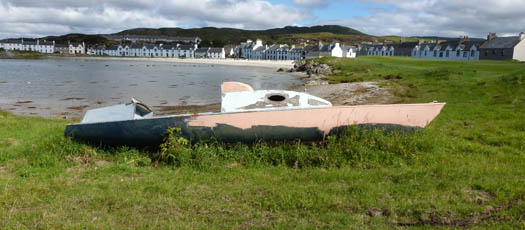
The cabins added later wouldn't have won a design prize, but they were probably quite effective within their limits. Photo: W M Nixon
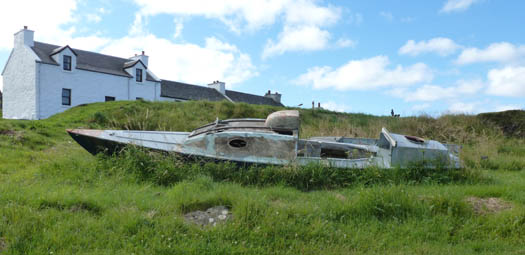
It's an International Olympic Soling in her final incarnation, sleeping in the sun on a Scottish island. Photo: W M Nixon
Detecting New Irish Sailing Talent
#olympicsailing – The Olympic Games are, for the general public, the pinnacle of sport. More than the World Championships or other events, the Olympics are the showcase for all disciplines, the only time that many can hope to reach a wide audience, the one moment when a sport can hope to be shown live on television. Sailing is no exception.
Results in the Olympics are important. The media will celebrate, possibly to excess, any success. Media coverage attracts finance, through sponsorship and grants. More importantly, success attracts newcomers to the sport, and boosts the enthusiasm of those already involved.
This year Irish athletes enjoyed great success in boxing and sailing got its best result in 32 years. But for me, the real revelation of the 2012 Olympics was the way that some sports, especially in Britain, had developed strategies for detecting and developing athletes from outside the the community of regular participants.
Rowing in Britain, has traditionally been a sport associated with certain schools, colleges and clubs.
The most famous race is of course the Oxford and Cambridge Boat Race which attracts millions of spectators. Even the Olympic rowing event was held on a school rowing lake. Elite rowers emerged from a limited number of institutions. Most adult participants attended a "rowing school". Am I alone in detecting a similarity with certain sports in Ireland?
GB Rowing decided to look elsewhere for potential athletes. This was a long term strategy, more for 2016 and 2020 than the London Olympics. They set up the Start Programme. Coaches would visit secondary schools with no tradition of rowing. The initial selection was simple: boys must be more than 1m88 (6ft2in), girls 1m78 (5ft10). Arm span must be equal to or greater than height. These candidates are then tested for leg power and upper body strength, and for mental toughness and endurance. The potential champions are then encouraged to enter a training programme organised with clubs and training centres. One third of the 2012 rowing team had emerged from this scheme, or a similar programme, Sporting Giants, aimed at detecting potential elite rowers, volleyball and handball players
A similar initiative lead to Ann Williams' remarkable Gold Medal in the skeleton event at the 2010 Winter Olympics. Originally a 400 metre runner she had a trial run on a simulator (if I understand the story correctly she was only testing the machine to see if it functioned correctly) at the University of Bath, which lead to her being offered a place on a training programme.
These schemes represent a change of direction in coaching. Rather than develop the physical capacity the of athletes who already compete in a sport, coaches seek to match the body shape, physiological and psychological aptitudes of a potential competitor to the needs of a particular sport, then teach them the technique. This may be difficult for some athletes and their parents renouncing their dreams of success in one particular sport. Mummy and Daddy may both have played hockey at school, but if their son is already nearly 6ft at the age of 13, they may have to get used to washing dirty rugby kit or standing on the shores of a windswept lake watching the boats go by! This approach also requires a great degree of cooperation between sports.
Sailing is more complicated sport than many others. Good technique and physical fitness are essential but not enough. Tactics, strategy, preparation of boat and sails are as important. Relatively simple physical tests will not reveal a potential champion. However, most sailing instructors can pick out promising beginners after only a few sessions In the same way, coaches can identify the talented improver who has potential.
To succeed any detection programme for sailing must:
− increase the proportion of any generation of schoolchildren who get the chance to discover sailing;
− facilitate the development of enthusiastic young sailors, in particular by removing or lowering the financial barriers to pursuing the sport.
At present numbers of young adults seriously racing dinghies is desperately small. Around 150 student are actively team racing in college at any one time (many of these students now spend 5 years in college). If we double this figure to include those who study abroad, or who chose not to team race, we can estimate there may be only 300 active dinghy sailors in the 18-25 age group emerging per Olympic cycle.
Many are lost to dinghy sailing as they leave school and parental financial support diminishes.We all know of promising young sailors who are snapped up by keelboat or cruiser-racing skippers. For a youngster on a budget this is the cheapest route to good sailing. However, dinghy sailing – which is what Olympic sailing is about – is the poorer by their absence.
It could be said that we only need to produce one Olympic sailor per class every generation. However, adapting a well known business principle: for every 100 youngsters who discover sailing, 10 will develop as good sailors and 1 will become an elite sailor. The more young athletes who enter sailing and work their way through the system the more chance we have of significant results.
Increasing the number of children and teenagers who learn sailing can be achieved. The example of Schull Community College is there to demonstrate how effective a school based scheme can be. Elsewhere in Europe, regional initiatives have been developed in which all primary school children learn to sail. The rationale behind such schemes are not only to develop the sport. In coastal regions, sailing is seen as an essential component of the tourism industry, to attract those who sail but also, more importantly, because strolling down the quay to watch the yachts is part of any seaside holiday. It is difficult to envisage the development of tourism based on any, or all, of the water-sports, without a minimum level of participation in the activity by local inhabitants. Local people sailing will help generate tourism revenue.
The investment required is relatively small. If a local authority can cooperate with a local club, who would already have some of the facilities, then the provision of a fleet of roto-moulded (or aluminium) boats, the instructors, RIBS and other equipment is no more a major expense than providing other public sports facilities such as soccer pitches, swimming pools etc. Imagine if all the 10 year old's in Dun Laoghaire-Rathdown, Finglas or Cork learnt to sail, as they do in Brest.
Such a scheme would greatly increase the number of children who want to sail (and also the number of parents with an interest in getting them sailing). The next stage is more delicate. At present, a developing sailor is funded directly by their parents. The notion of a club as a structure that exists to provide all the facilities for young sailors to develop is not common here in Ireland. Boats, sails, coaching, travel to training camps and events have to be paid for by individual parents. Any funding is funnelled to those who have already demonstrated that they can get results.
How many potentially excellent sailors are lost to the sport because of this financial barrier? Nearly new boats, new sails and other expenses are considered essential for success. Especially in the current economic climate the number of families who can afford such an investment, in the hope that their child can progress is limited. This may explain why so many of these young sailors come from a "sailing background". These are families in which the sacrifices needed to fund sailing have already been part of the family lifestyle, sometimes for several generations.
We need to develop a more gradual approach. Consider the policy developed by the French Federation. After learning to sail a teenager joins the local sailing centre's Sport School. Training sessions and races at a local level are organised using club boats, few of which could be considered as "nearly new". Only when the youngster is achieving consistent good results will they move on to the Club Team.
Every race now becomes critical. National ranking points are awarded for every race. Within the club the allocation of boats is decided by the sailor's ranking. If you want to sail the new club 420 then you need to be the top ranked sailor in your group. Between clubs, allocation of funding and grants depends on the club's ranking. Needless to say competition is ferocious. Only when sailors get to the very top level do they get access to new boat and new sails.
Talking with the administrator of a small French sailing centre, recently, he insisted that the role of adult volunteers was to provide facilities so that all local children could go sailing.
It could be said that there are not enough sailors in Ireland to run such a system. However, if a greater number of children discover sailing, and there is a reasonably priced development pathway, numbers will increase. Merely reducing the difference between the number of children on "Taste of Sailing " courses, and the number who are still sailing dinghies at the age of 18 would significantly increase participation levels.
A recent Sports Council announcement for sailing is a welcome step in this direction. By providing coaching equipment for training camps removes a major expense for many sailing families. Four mobile training fleets are to be used for introductory programmes. There is still a gap between introductory courses and elite training.
Maybe it is time to reflect on how we can lower the barrier for those sailors who have been introduced to sailing and who wish to work towards the National and Regional Squads. One aim would be to develop an intermediate level of training and competition in which children and parents are encouraged not to invest in new equipment, private coaching and other major expenses.
– Magheramore
Irish Sailing Gets Biggest Sports Grant for 'Mobile Training Fleets'
#sailing – Minister of State for Tourism & Sport Michael Ring has approved a grant of €400,000 for sailing, the biggest of all grants awarded today to 22 national sports bodies to buy new equipment and boost participation in sports and improve performance.
The sailing grant which is 15% of the total payout is awarded for "mobile training fleets, transport vans, coach boats, coaching equipment, Olympic sailing equipment and training camp equipment (excluding eyewear)."
The ISA says the funds will be spent on coaching equipment including coach boats, vehicles and training equipment, Olympic sailing equipment including a fleet of 420's, Laser Radials and a 49er with associated spares for training camps and training camp equipment which includes strength and conditioning apparatus to be used on training camps.
The ISA will also fund for four mobile training fleets for use on introductory ISA training programmes. The aim is to provide support for organisations looking to develop junior, schools and introductory adult programmes.
The funding has been awarded to a range of National Governing Bodies including the Athletics Association, the Irish Rugby Football Union, Irish Wheelchair Association Sport, Canoeing Ireland, the GAA, the Irish Sailing Association, the Football Association of Ireland, and the Ladies Gaelic Football Association.
The new equipment will include items as diverse as a mobile Olympic Handball arena, scrum machines, a 'cricket factory' where you can try out cricket for fun, and martial arts arenas.
It includes a grant of €160,228 to the Irish Wheelchair Association Sport to provide new equipment for sports like basketball, athletics, hand cycling and rugby, boccia, table tennis, archery, frisbee, tennis, powerlifting and gym equipment.
Minister Ring said: 'The real beneficiaries from this funding will be the thousands of sportspeople across Ireland who head out on weeknights and weekends to train with their local club. Although some of the equipment will be used at national level by the governing bodies, a significant portion will be utilised at local level. I hope it will encourage more people to get involved in sport'.
The equipment aims to help a diverse range of sports to attract more participants, run better competitions, monitor performance and train more effectively, building on the success of the London 2012 Olympic and Paralympic Games.
Applications were invited through the Irish Sports Council. All 22 organisations which applied are being funded under the scheme.
| Organisation | Allocation | Grant purpose |
| Athletics Association of Ireland | €350,000 | club athletic equipment, sports hall indoor competition, track and field competition, speed gates, dartfish analysis, GPS heart rate monitors and lactate machines |
| Badminton Ireland | €90,000 | para badminton chairs, school kits, target cage, posts and nets |
| Canoeing Ireland | €75,000 | boats, racks and gym equipment |
| Community Games | €85,899 | national finals equipment upgrade/replenishment, area equipment packs (165) and county equipment packs (40) |
| Cricket Ireland | €105,921 | performance analysis equipment, cricket factory (to allow people to try cricket), BOLA fielding machine |
| Football Association of Ireland | €220,000 | footballs, training equipment, fitness equipment, goalposts and football for all specialist equipment |
| GAA | €220,000 | footballs, sliotars, bibs, cones and portable goalposts |
| Institute of Sport | €121,489 | performance analysis, strength and conditioning, medical, physiotherapy and physiology |
| Irish Hockey Association | €30,000 | throw down lines, hockey sticks, outdoor and indoor hockey balls, equipment bags, backboards and heart rate monitors |
| Irish Martial Arts Commission | €84,525 | mobile stage, boxing ring and floor mats |
| Irish Olympic Handball Association | €98,000 | balls, iGoals, match equipment, mobile arena |
| Irish Rugby Football Union | €257,517 | equipment for clubs and schools, defibrillators, GPS tracking system, scrum machines, match and training equipment |
| Irish Sailing Association | €400,000 | mobile training fleets, transport vans, coach boats, coaching equipment, Olympic sailing equipment and training camp equipment (excluding eyewear) |
| Irish Table Tennis Association | €7,000 | tables, surrounds, nets, training equipment |
| Irish Wheelchair Association Sport | €160,228 | basketball, athletics, hand cycling, rugby, boccia, table tennis, archery, frisbee, tennis, powerlifting and gym equipment |
| Junior Golf Ireland | €17,500 | golf kits for schools |
| Ladies Gaelic Football Association | €15,000 | tutor packs |
| Motor Cycling Ireland | €16,867 | timing system |
| Special Olympics Ireland | €26,153 | athletics throws, bocce carpets, floorball rink, tennis and table tennis |
| Swim Ireland | €249,586 | UL, National Aquatic Centre and Connacht high performance centres |
| Volleyball Association of Ireland | €11,390 | international standard equipment for suitable sports halls |
| Weightlifting Ireland | €20,430 | weightlifting Equipment |
| Total | €2,662,505 |
Irish Olympic 470 Ace Lying Seventh at GP14 Worlds in Cornwall
#gp14 – It was only a short hop from Weymouth to Cornwall last week when the Olympic regatta finished for Irish 470 sailor Ger Owens who is currently placed seventh overall at the GP14 World championships underway at Looe Sailing Club in Devon today.
The Dun Laoghaire sailor with new crew Scott Flannigan rounded off his third Olympics in the 470 with with a 16th and a 5th on the final day to leave the pair 23rd overall.
Now the Royal St. George helm, who will miss out on tonight's OIympic homecoming at the National YC, has teamed up with Melanie Morris to lead Irish hopes at the 130-boat GP 14 event in which there is a strong Irish presence.
Moville Boat Club's John and Donal McGuiness are next Irish in ninth. Shane McCarthy and Andy Thompson from Greystones Sailing Club are in 13th place.
Racing continues today. Results here.
Annalise Loses Out on Medal in Thrilling Olympic Finale
#Annalise_murphy – There was Olympic heartbreak for Annalise Murphy on one of the toughest race courses today when the 22–year–old Dun Laoghaire sailor finished fourth overall but only after a tense four way battle saw the Irish Olympic debutante lose out in the final moments of the 50 minute medal race.
The downwind finish was ultimately a tough leg for one of the biggest girls in the fleet. Nevertheless the sporting moment provided not only sailors but the entire country with a great lift when the Irish girl arrived in gold medal position at the first windward mark.
"Hard luck Annalise. You did us proud. Seeing the tricolour come around the first mark in gold medal position was as good as Packie Bonner's save or Dave O'Leary's penalty at Italia 90", wrote one reader on Afloat.ie
Murphy finished the race fifth to be fourth overall. Though there is no Irish medal it is Ireland's best Olympic sailing result in 32 years. Understandably that will be of small consolation to an emotional Annalise in Weymouth this afternoon.
Ashore after racing Annalise said "Coming fourth was definitely the worst result. "I kept losing out downwind because I kept going left downwind and there was less wind. Things just didn't work my way".
"I'm only 22. I'm going to work so hard and be back for 2016", a tearful but positive Annalise said.
In a set of conditions that could not have been more different to those that blasted Annalise into the lead of the Olympic regatta last week, Ireland's Annalise set sail on her final voyage for Gold in Weymouth in 12 knot westerlies and sunshine.
Going in to the medal race Annalise was third overall on 34 points with arch rival Van Acker from Belgium. The lead was held jointly by Liljia Xu and the world champion Marit Boumeester both on 33 points. Paddy Power bookmaker gave odds of 11/4 to Annalise. Boumeester was on 9/4, Liljia Xu 5/2 and Van Acker 11/4.
A tense four-way battle loomed as Ben Ainslie's girlfriend Marit Boumeester of Holland, the reigning radial world champion went for a matching Gold medal.
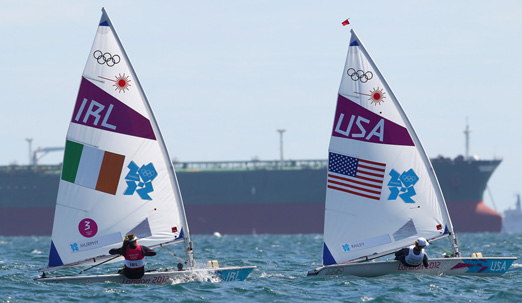
Annalise chases bronze medal position in the medal race today. Photo: Richard Langdon
Annalise had a mid line start in the stable 12 knot breeze and her upwind speed was clear to see. The Irish girl rounded the weather mark first but China's Lijia Xu quickly passed her on the run. Annalise appeared slow downwind, dropping eight places by the first leeward mark.
China rounded ahead of Holland's Marit Bouwmeester going into the second lap of the race. The other contender Van Acker of Belgium was last with Annalise in seventh place.
But by the top of the second weather mark Annalise was back in silver medal position again storming upwind just behind China with Van Acker on her heels in third having gained on the right.
But Annalise dropped back again on the second run. Boumeester motored down the run into second for the last lap, pulling the rabbit out of the hat downwind.
Annalise rounded the leeward mark for the second time fifth and out of the medals. But on the final upwind leg Annalise was again back in contention. The Dun Laoghaire sailor and Van Acker dueling for Bronze as Xu and Boumeester fought for gold and silver.
One thing was for sure, the Nothe course was never boring with places changing on every leg in the 12-14 knot winds.
On the final downwind leg Annalise was in bronze medal position with Van Acker two boats behind in sixth.
All four sailors from all four nations were neck and neck in the last few moments of the race. Thirty seconds or so separating the top five boats. Crafty Van Acker sailed back in to contention catching a series of good gusts leaving Ireland with Olympic agony just metres from the finish line.
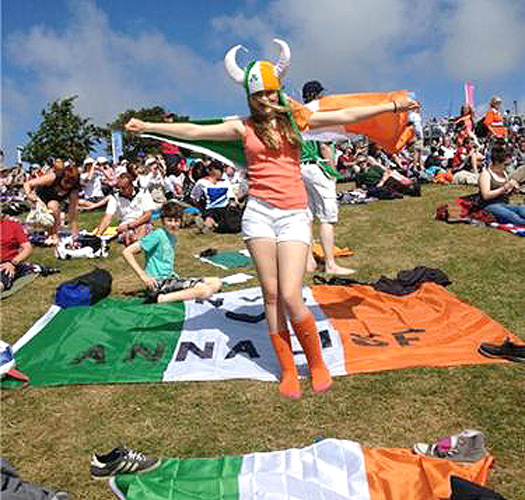
Irish fans were out in force in Weymouth, 'Annalise's army' positioned right in front of the Nothe course. Photo: Finn Murphy
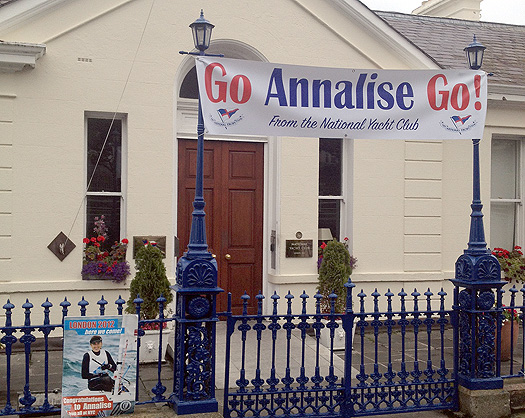
Annalise's club, the National Yacht Club on the East Pier in Dun Laoghaire, had the bunting out for today's medal race and her sailing students were jumping for joy all week. Photos: Michael Chester
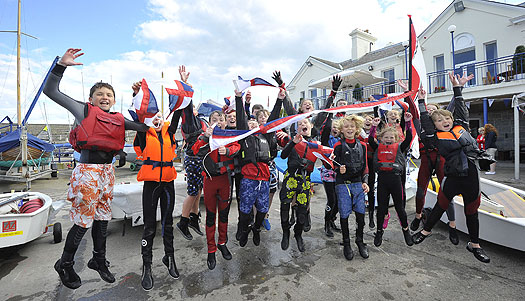
Puspure Ends Well at Olympic Rowing Regatta With Win in C Final
# ROWING: Sanita Puspure won the C Final of the women’s single sculls with great ease at the Olympic Games regatta at Eton Dorney today, placing her 13th overall. Micheen Thornycroft of Zimbabwe showed well early on, but Puspure took over in the second quarter of the race and had a clear one-length lead by 1250 metres. She then pushed on to win by almost eight seconds.
The A Final winner was Mirka Knapkova of the Czech Republic. Silver and bronze went to Fie Udby Erichsen of the Denmark and Kim Crow of Australia.
In an interesting twist, the Olympic Qualification Regatta in Lucerne had been a good indicator of form at Eton Dorney. Crow had won there, while Erichsen had finished second. Genevra Stone of the United States, who was third in Lucerne, won the Olympic B Final (seventh overall), while Puspure was fourth in Lucerne. Crow had a great Olympics, taking silver in the double sculls.
Olympic Games Regatta, Eton Dorney (Irish interest)
Women’s Single Sculls – C Final (places 13 to 18): 1 Ireland (S Puspure) 7:59.77, 2 Zimbabwe (M Thornycroft) 8:07.52, 3 Cuba (Y Cobas Garcia) 8:14.59, 4 El Salvador 8:19.75, 5 Thailand 8:34.11, 6 Brazil did not start. A Final: 1 Czech Republic (M Knapkova) 7:54.37, 2 Denmark (FU Erichsen) 7:57.72, 3 Australia (K Crow) 7:58.04.



























